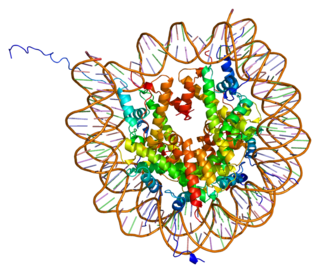Core histone macro-H2A.1 is a protein that in humans is encoded by the H2AFY gene. [5] [6] [7]
Core histone macro-H2A.1 is a protein that in humans is encoded by the H2AFY gene. [5] [6] [7]
Histones are basic nuclear proteins that are responsible for the nucleosome structure of the chromosomal fiber in eukaryotes. Nucleosomes consist of approximately 146 bp of DNA wrapped around a histone octamer composed of pairs of each of the four core histones (H2A, H2B, H3, and H4). The chromatin fiber is further compacted through the interaction of a linker histone, H1, with the DNA between the nucleosomes to form higher order chromatin structures. This gene encodes a member of the histone H2A family. It replaces conventional H2A histones in a subset of nucleosomes where it represses transcription and participates in stable X chromosome inactivation. Alternative splicing results in multiple transcript variants encoding different isoforms. [7] Expression of these isoforms is associated to several cancers, such as hepatocellular carcinoma. [8]
Chromatin is a complex of DNA and protein found in eukaryotic cells. The primary function is to package long DNA molecules into more compact, denser structures. This prevents the strands from becoming tangled and also plays important roles in reinforcing the DNA during cell division, preventing DNA damage, and regulating gene expression and DNA replication. During mitosis and meiosis, chromatin facilitates proper segregation of the chromosomes in anaphase; the characteristic shapes of chromosomes visible during this stage are the result of DNA being coiled into highly condensed chromatin.

A nucleosome is the basic structural unit of DNA packaging in eukaryotes. The structure of a nucleosome consists of a segment of DNA wound around eight histone proteins and resembles thread wrapped around a spool. The nucleosome is the fundamental subunit of chromatin. Each nucleosome is composed of a little less than two turns of DNA wrapped around a set of eight proteins called histones, which are known as a histone octamer. Each histone octamer is composed of two copies each of the histone proteins H2A, H2B, H3, and H4.

Histone H2A is one of the five main histone proteins involved in the structure of chromatin in eukaryotic cells.
Histone methylation is a process by which methyl groups are transferred to amino acids of histone proteins that make up nucleosomes, which the DNA double helix wraps around to form chromosomes. Methylation of histones can either increase or decrease transcription of genes, depending on which amino acids in the histones are methylated, and how many methyl groups are attached. Methylation events that weaken chemical attractions between histone tails and DNA increase transcription because they enable the DNA to uncoil from nucleosomes so that transcription factor proteins and RNA polymerase can access the DNA. This process is critical for the regulation of gene expression that allows different cells to express different genes.

Histone H4 is a protein that in humans is encoded by the HIST4H4 gene.

Centromere protein A, also known as CENPA, is a protein which in humans is encoded by the CENPA gene. CENPA is a histone H3 variant which is the critical factor determining the kinetochore position(s) on each chromosome in most eukaryotes including humans.

Histone H2A.Z is a protein that in humans is encoded by the H2AZ1 gene.
Histones are basic nuclear proteins that are responsible for the nucleosome structure of the chromosomal fiber in eukaryotes. Nucleosomes consist of approximately 146 bp of DNA wrapped around a histone octamer composed of pairs of each of the four core histones. The chromatin fiber is further compacted through the interaction of a linker histone, H1, with the DNA between the nucleosomes to form higher order chromatin structures. The H2AFZ gene encodes a replication-independent member of the histone H2A family that is distinct from other members of the family. Studies in mice have shown that this particular histone is required for embryonic development and indicate that lack of functional histone H2A leads to embryonic lethality.

Histone H2A type 2-C is a protein that in humans is encoded by the HIST2H2AC gene.

Histone H1.1 is a protein that in humans is encoded by the HIST1H1A gene.

Histone chaperone ASF1A is a protein that in humans is encoded by the ASF1A gene.

Histone H2B type 1-L is a protein that in humans is encoded by the HIST1H2BL gene.

Histone H2B type 1-M is a protein that in humans is encoded by the HIST1H2BM gene.

Histone H2B type 1-A is a protein that in humans is encoded by the HIST1H2BA gene.

Histone H1.2 is a protein that in humans is encoded by the HIST1H1C gene.

Histone H2A type 2-B is a protein that in humans is encoded by the HIST2H2AB gene.

Histone H2A.V is a protein that in humans is encoded by the H2AFV gene.

Chromodomain-helicase-DNA-binding protein 1-like (ALC1) is an enzyme that in humans is encoded by the CHD1L gene. It has been implicated in chromatin remodeling and DNA relaxation process required for DNA replication, repair and transcription. The ALC1 comprises ATPase domain and macro domain. On the basis of homology within the ATPase domain, ALC1 belongs to Snf2 family.

Histone H2A.J is a protein that in humans is encoded by the H2AFJ gene.

Histone H2A-Bbd type 1 also known as H2A Barr body-deficient is a histone protein variant that in humans is encoded by the H2AFB1 gene.

Histone H2A-Bbd type 2/3 also known as H2A Barr body-deficient is a histone protein that in humans is encoded by the H2AFB2 gene.